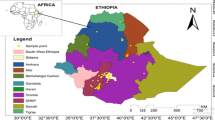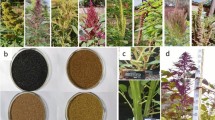Abstract
A total of 229 genotypes of 20 Amaranthus species from the United States Department of Agriculture – Agricultural Research Service (USDA – ARS) National Plant Germplasm Amaranth Collection was evaluated in field experiments in Beijing and Wuhan, China, in 1994. Agronomic traits, including plant height, maturity, leaf number and color, stem color, seed color, branch number, 1000-grain-weight, yield per plant, and resistance to stresses (including diseases) were measured. The results indicated: 1. Many of the species were sensitive to daylength; 2. Cultivated genotypes generally had higher grain yield but were more seriously affected by diseases than non-cultivated species; 3. There was wide diversity in agronomic traits among Amaranthus species and among genotypes within the same species, and several genotypes were identified that appeared to carry favorable agronomic traits of immediate use in cultivar improvement; 4. For introduction of genotypes for use in plant breeding in China, selection should be partially based on matching the climates of the location of origin and the target area for production.
Similar content being viewed by others
References
Becker, R., E.L. Wheeler, K. Lorenz, A.E. Stafford, O.K. Grosjean, A.A. Betschart & R.M. Saunders, 1981. A compositional study of Amaranth grain. J. Food Sci. 46: 1175–1180.
Breene, W.M., 1991. Food uses of grain Amaranth. Cereal Foods World 36: 426–430.
Bressani, R., E.C.M. De Martell & C.M. De Godinez, 1993. Protein quality evaluation of Amaranth in adult humans. Plant Foods Hum. Nutr. 43: 123–143.
Del Valle, F.R., M. Escobedo, A. Sanchez-Marroquin, H. Bourges, M.A. Bock & P. Biemer, 1992. Nitrogen balance in infants fed formulas containing Amaranth or a soy-oats formula. Cereal Chem. 69: 156–159.
Del Valle, F.R., M. Escobedo, A. Sanchez-Marroquin, H. Bourges, M.A. Bock & P. Biemer, 1993. Chemical and nutritional evaluation of two amaranth (Amaranthus cruentus)-based infant formulas. Plant Foods Hum. Nutr. 43: 145–156.
Espitia-Rangel, E., 1994. Breeding of grain amaranth. In: O. Paredes-López (Ed.), Amaranth: Biology, Chemistry, Technology, pp. 23–38.
Grubben, G.J.H., 1993. Amaranthus L. In: Siemonsma, J. S. & K. Piluek (Eds.), Prosea: Plant Resources of South-East Asia 8. Vegetables. pp. 82–86.
Guzmán-Maldonado, H. & O. Paredes-López, 1994. Production of high-protein flour and maltodextrins from amaranth grain. Process. Biochem. 29: 289–293.
Kauffman, C.S., 1992. The status of grain amaranth for the 1990s. Food Rev. Int. 8: 165–185.
Kigel, J., 1994. Development and ecophysiology of amaranths. In: O. Paredes-López (Ed.) Amaranth: Biology, Chemistry, and Technology, pp. 39–74.
Kulakow, P.A. & H. Hauptli, 1994. Genetic characterization of grain amaranth. In: O. Paredes-López (Ed.) Amaranth: Biology, Chemistry, and Technology, pp. 9–22.
National Research Council, 1984. Amaranth modern prospects for an ancient crop. National Academy Press.
Sanchez-Marroquin, A., F.R. Del Valle, M. Escobedo, R. Avitia, S. Maya & M. Vega, 1986. Evaluation of whole amaranth (Amaranthus cruentus) flour, its air-classified fractions, and blends of these with wheat and oats as possible components for infant formulas. J. Food Sci. 51: 1231–1234.
Sánchez-Marroquin, A., M.V. Domingo, S. Maya & C. Saldaña, 1985. Amaranth flour blends and fractions for baking applications. J. Food Sci. 50: 789–794.
Saunders, R.M. & R. Becker, 1984. Amaranthus: A potential food and feed resource. In: Y. Pomeranz (Ed) Advances in Cereal Science and Technology Vol VI. American Assoc. Cereal Chemists, Inc., St. Paul, MN.
Singhal, R.S. & P.R. Kulkarni, 1988. Composition of the seeds of some Amaranthus species. J Sci. Food Agric. 42: 325–331.
Sreelathakumary, I. & K.V. Peter, 1993. Amaranth-Amaranthus spp. In: Genetic Improvement of Vegetable Crops, pp. 315-323. Pergamon Press.
Teutonico, R.A. & D. Knorr, 1985. Amaranth: composition, properties, and applications of a rediscovered food crop. Food Technol. 4: 49–54.
Wu, H., S. Yue, H. Sun & H. Corke, 1995. Physical properties of starch from two genotypes of Amaranthus cruentus of agricultural significance in China. Starch/Stärke 47: 295–297.
Yue, S.X., H.L. Sun & F.D. Tang, 1993. The Research and Development of Grain Amaranthus in China. Agricultural Science and Technology Publishing House, Beijing, China (in Chinese).
Author information
Authors and Affiliations
Corresponding author
Rights and permissions
About this article
Cite this article
Wu, H., Sun, M., Yue, S. et al. Field evaluation of an Amaranthus genetic resource collection in China. Genetic Resources and Crop Evolution 47, 43–53 (2000). https://doi.org/10.1023/A:1008771103826
Issue Date:
DOI: https://doi.org/10.1023/A:1008771103826




